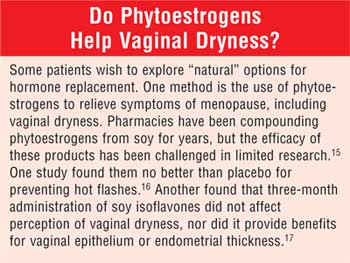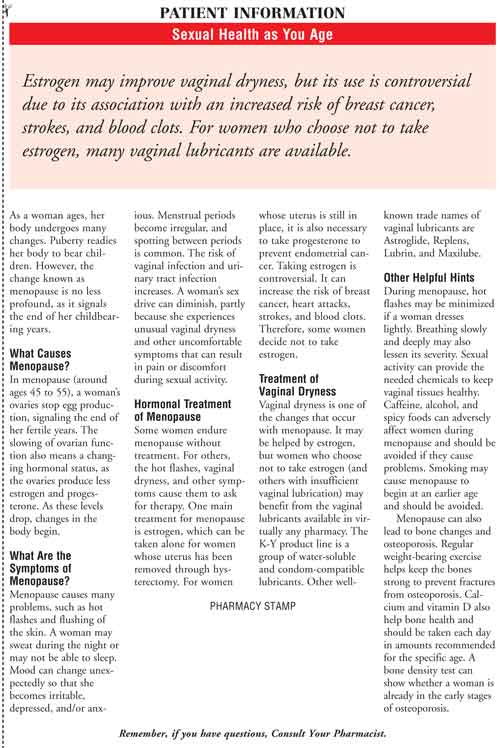US Pharm. 2006;31(9):10-15.
Atrophic vaginitis is a common
disorder that causes dryness of the vaginal tissues and other troubling
symptoms. As the average age of the population rises, knowledge of self-care
interventions for age-linked conditions such as atrophic vaginitis is becoming
increasingly important. Thus, pharmacists must know which products can be
recommended for this condition.
Prevalence
Investigators
surveyed a cohort of postmenopausal females ages 50 to 79 to determine the
prevalence of self-reported urogenital symptoms, including those indicative of
atrophic vaginitis.1 The most common symptom was vaginal dryness,
affecting 27% of respondents. Irritation or itching was reported by about 19%
and discharge by approximately 11%. Symptoms were more common in Hispanic
females, obese women, and those with diabetes mellitus. In other research, 43%
of women age 61 experienced vaginal dryness; 10% experienced vaginal burning.2
Examining the incidence of vaginal dryness alone illustrates the strong age
link: Only 3% of women of reproductive age are troubled by it.3
However, the incidence increases to 4% of women in their early menopausal
transition, 21% of those in their late menopausal transition, and 47% of women
three years postmenopause.3
Epidemiology
The major causal
factor in atrophic vaginitis is insufficient estrogen. Inadequate levels of
estrogen can be the result of several medical conditions. The most common is
menopause.4 The average age at which women experience menopause is
51 years.5 Generally, symptoms of atrophic vaginitis are noticeable
five to 10 years after menopause begins. Premenopausal patients may also
experience atrophic vaginitis when they undergo surgical removal of the
ovaries.6 Women with such conditions as endometriosis or uterine
fibroids may take medications that decrease estrogen; as a result, they can
experience subsequent atrophic vaginitis.6
Breast-feeding can cause
atrophic vaginitis.6 In addition, cigarette smoking can affect
vaginal tissues adversely, reducing blood perfusion and the bioavailability of
estrogen.6 (Smoking also lowers the age at which menopause begins.5)
Sjögren's syndrome affects
four million Americans, with a female-to-male ratio of 9:1.7 One
component of the syndrome in women is vaginal dryness, accompanied by dryness
in the eyes, mouth, skin, nose, and lungs.
Manifestations of the
Condition
Several vaginal
changes characterize atrophic vaginitis.6 One such change involves
intra vaginal tissues. Normal intravaginal epithelium is rugated, consisting
of tissues with folds, ridging, and wrinkling. Estrogen is responsible for
maintaining the appropriate vaginal rugosity. However, with insufficient
estrogen, the rugae decrease in prominence, causing vaginal tissues to develop
a smooth, shiny, thin, and pale appearance. These changes are accompanied by
numerous petechial hemorrhages, erythema, inflammation, bleeding, friability
of tissues, and discharge.6
Changes in collagen and
elastic fibers of vaginal tissues have profound consequences.6
Collagen fibers swell and fuse, while elastic fibers fragment. As a result,
the vagina develops an abnormally restricted architecture, becoming more short
and narrow than it was when the patient was younger. The vagina also loses
elasticity and has a decreased ability to distend during sexual activity.
Vaginal lubrication decreases, causing pruritus and leukorrhea.6
The net result of many vaginal changes that characterize atrophic vaginitis is
decreased sexual pleasure. Urinary symptoms also occur, including dysuria,
urgency, and incontinence.2
Benefits
of Sexual Activity
Vaginal dryness and
other changes cause dyspareunia for a significant number of women.5
This condition may lead to avoidance of sexual activity. However, avoidance
contributes to the problem, because intercourse enhances vaginal blood flow
and helps preserve tissues in their more youthful state.6
Furthermore, vaginal health is improved when tissues are bathed by the
steroids, prostaglandins, and essential fatty acids present in male ejaculate.

Prescription Products
A discussion of
prescription options for vaginal and urinary symptoms of menopause is beyond
the scope of this review. However, physicians might consider the use of
estrogens (either orally or in the form of transdermal patches or gels),
intravaginal rings (Estring), vaginal tablets (Vagifem), or vaginal creams
(Estrace).8
Nonprescription Vaginal Lubricants
Patients may choose
from numerous vaginal lubricants. All lubricants provide relief of vaginal
dryness, but they differ in several important parameters, such as the number
and variety of line extensions marketed under each trade name, dosage forms,
and auxiliary benefits claimed by their manufacturers.9
The K-Y brand and its line
extensions are the most familiar set of products for vaginal lubrication.10
All are compatible with condoms. The most well known is K-Y Jelly, consisting
of purified water, glycerin, hydroxyethylcellulose, chlorhexidine gluconate,
gluconolactone, methylparaben, and sodium hydroxide. (The manufacturer does
not list concentrations on the labels of its products.) The jelly may be used
as needed to provide comfort with sexual activity. Its consistency allows easy
postcoital removal. It is unique among the K-Y product line-up in that the
manufacturer recommends its use for easing rectal insertion of thermometers or
enema nozzles and vaginal insertion of tampons.
K-Y Ultragel is advertised as
a smooth product that is "less messy," being somewhat thinner than the jelly.
The company also claims that it is superior to K-Y Jelly, due to its smoother
consistency and enhanced duration. Its ingredients are purified water,
propylene glycol, sorbitol, polysorbate 80, Natrosol 250H, benzoic acid,
methylparaben, and vitamin E.
K-Y Liquid is a fully liquid
product, with purified water, glycerin, sorbitol, propylene glycol, Natrosol
250H, benzoic acid, methylparaben, and sodium hydroxide. The company claims
that this product is also smoother and longer lasting than the original jelly.
With K-Y Warming Liquid, the manufacturer claims that application produces
gentle warming. On a company-sponsored list of frequently asked questions, the
manufacturer states that warming is produced through the use of a "unique
patented mixture that is proprietary to the brand" and also assures readers
that it has been tested and found safe for use.10 The labeled
ingredients are propylene glycol, glycerin, purified honey, and methylparaben.
According to the product
packaging, K-Y Silk-e Liquid resembles the patient's natural moisture. The
list of ingredients is similar to that of K-Y Ultragel but adds aloe vera and
substitutes polysorbate 60 for 80. The manufacturer of K-Y Long Lasting
promises the product will last for days, with an ingredient list that includes
purified water, glycerin, mineral oil, calcium/sodium PVM/MA copolymer, PVM/MA
decadiene crosspolymer, hydrogenated palm glyceride, methylparaben, benzoic
acid, vitamin E, and sodium hydroxide. It is important to note the presence of
mineral oil. Even though mineral oil degrades rubber products such as condoms,
the company Web site is insistent that all K-Y products are safe to use with
condoms. The manufacturer also markets a line of K-Y Sensual Mist products, a
unique dosage form among personal lubricants. The warming version of the mist
contains propylene glycol, PEG-400, and tocopherol.
Several other companies market
vaginal lubricants. The Astroglide brand includes a gel, liquid, warming
liquid, and Astroglide Silken Secret--a jelly marketed in prefilled
applicators. All are compatible with condom use.
Lubrin is a vaginal insert
that the manufacturer suggests inserting at least five minutes prior to
intercourse. It is designed to liquefy rapidly and provides several hours of
lubrication. If the patient discovers that one insert produces excessive
lubrication, half of an insert may be adequately effective. If the inserts are
exposed to extreme heat, they may melt. The patient should place the inserts
in a refrigerator for 24 hours, allowing them to resolidify without altering
their efficacy. A small chart on the insert enclosed in the Lubrin packaging
confirms that the inserts are compatible with condoms.
The manufacturer of Replens
attempts to differentiate its product from these by stressing that it is a
moisturizer rather than a lubricant.11,12 The Web site indicates
that other lubricants are useful mainly for coital purposes, while Replens
purportedly promotes "natural function of the vaginal lining."11
It is compatible with condoms. A study compared the purported bioadhesive
properties of polycarbophil (as used in Replens) versus pectin (as used in
other moisturizers).13 The researchers failed to discover any
unique advantage to the Replens formula in increasing vaginal lubrication.
A topical cream known as
Finally has been heavily promoted for enhancing sensitivity and pleasure for
females during sexual activity. How it might accomplish that is unknown, but
the company promises compatibility with condoms, implying that it might be
used as a lubricant. The ingredients include plants of unknown safety and
efficacy when applied vaginally, such as aloe, ginseng, palmaria/palmata,
Cananga odorata, and lavender. One report implicates lavender in contact
allergy that complicated a case of chronic vulvovaginitis.14
Products promoted to the lay public without FDA-approved evidence of safety
and efficacy should be scrutinized thoroughly before they are offered for sale
in pharmacies.
References
1. Pastore LM, Carter RA, Hulka BS, Wells E. Self-reported urogenital symptoms in postmenopausal women: Women's Health Initiative. Maturitas. 2004;49:292-303.
2. Carranza-Lira S, Fragoso-Díaz N, MacGregor-Gooch AL, et al. Vaginal dryness assessment in postmenopausal women using pH test strip. Maturitas. 2003;45:55-58.
3. Woods NF, Mitchell ES. Symptoms during the perimenopause: prevalence, severity, trajectory, and significance in women's lives. Am J Med. 2005;118(12 suppl 2):14-24.
4. Avis NE, Brockwell S, Colvin A. A universal menopausal syndrome? Am J Med. 2005;118(12 suppl 2):37-46.
5. Zapantis G, Santoro N. The menopausal transition: characteristics and management. Best Pract Res Clin Endocrinol Metab. 2003;17:33-52.
6. Castelo-Branco C, Cancelo MJ, Villero J, et al. Management of post-menopausal vaginal atrophy and atrophic vaginitis. Maturitas. 2005;52(suppl 1):S46-S52.
7. Schoofs N. Caring for women living with Sjögren's syndrome. J Obstet Gynecol Neonatal Nurs. 2003;32:589-593.
8. Ballagh SA. Vaginal hormone
therapy for urogenital and menopausal symptoms. Semin Reprod Med.
2005;23:
126-140.
9. Leiblum SR. Arousal disorders in women: complaints and complexities. Med J Aust. 2003;178:638-640.
10. K-Y Brand. Frequently Asked Questions. Available at: www.ky.com/faq.jsp. Accessed July 27, 2006.
11. Lil' Drug Store Consumer Products. Replens FAQs. Available at: www.lildrugstore.com/ReplensCat.aspx?Category=bb432550-4e6f-4440-aa20-0a96ab5b5bc6. Accessed July 27, 2006.
12. Willhite LA, O'Connell MB. Urogenital atrophy: prevention and treatment. Pharmacotherapy. 2001;21:464-480.
13. Caswell M, Kane M. Comparison of the moisturization efficacy of two vaginal moisturizers: pectin versus polycarbophil technologies. J Cosmet Sci. 2002;53:81-87.
14. Varma S, Blackford S, Statham BN, Blackwell A. Combined contact allergy to tea tree oil and lavender oil complicating chronic vulvovaginitis. Contact Dermatitis. 2000;42:309-310.
15. Van Voorhis BJ. Genitourinary symptoms in the menopausal transition. Am J Med. 2005;118(12 suppl 2):47-53.
16. Van Patten CL, Olivotto IA, Chambers GK, et al. Effect of soy phytoestrogens on hot flashes in postmenopausal women with breast cancer: a randomized, controlled clinical trial. J Clin Oncol. 2002;20:1449-1455.
17. Nikander E, Rutanen EM, Nieminen P, et al. Lack of effect of isoflavonoids on the vagina and endometrium in postmenopausal women. Fertil Steril. 2005;83:137-142.

To comment on this article, contact editor@uspharmacist.com.






